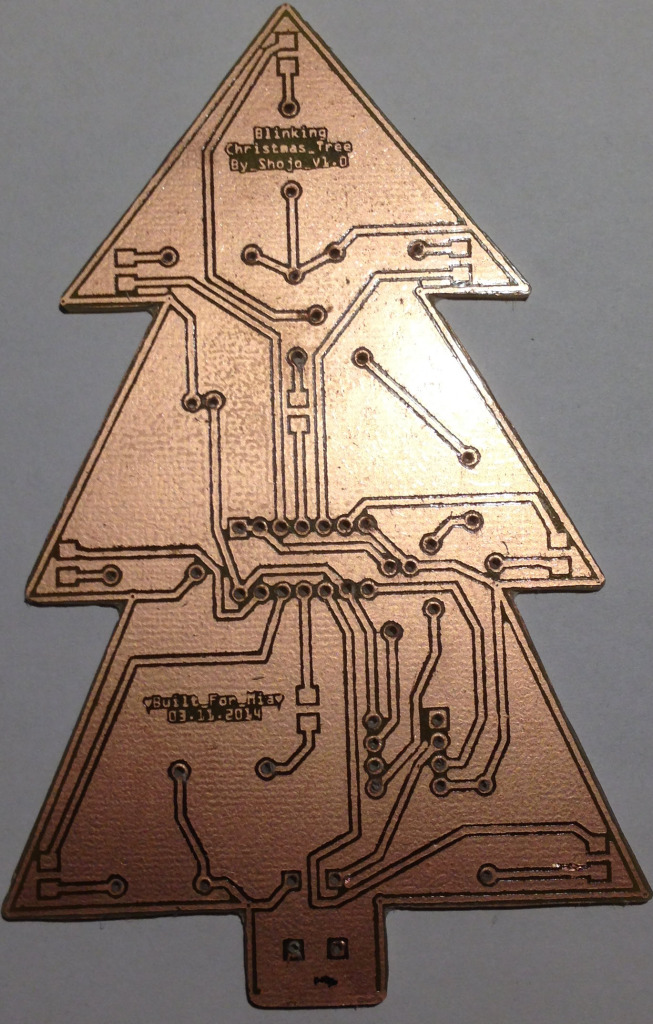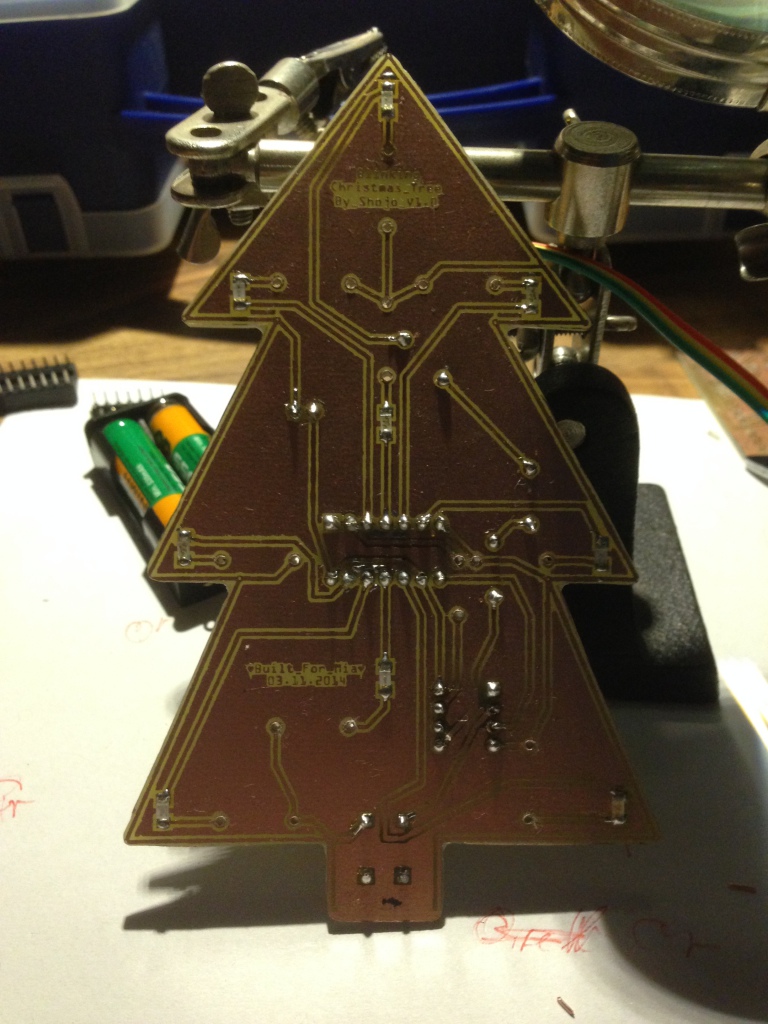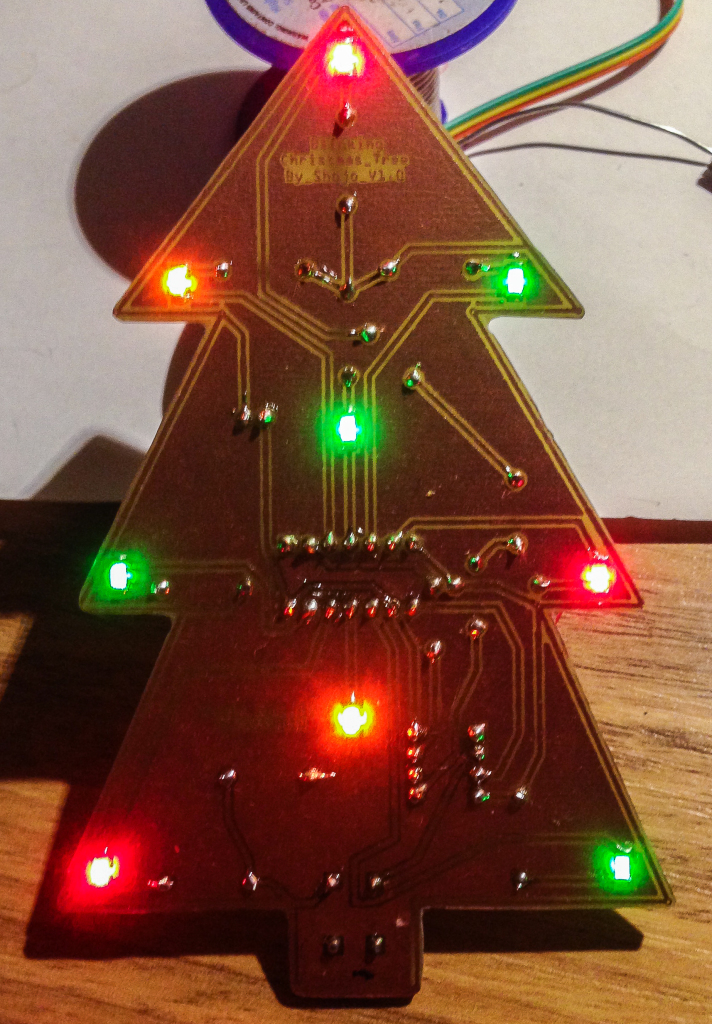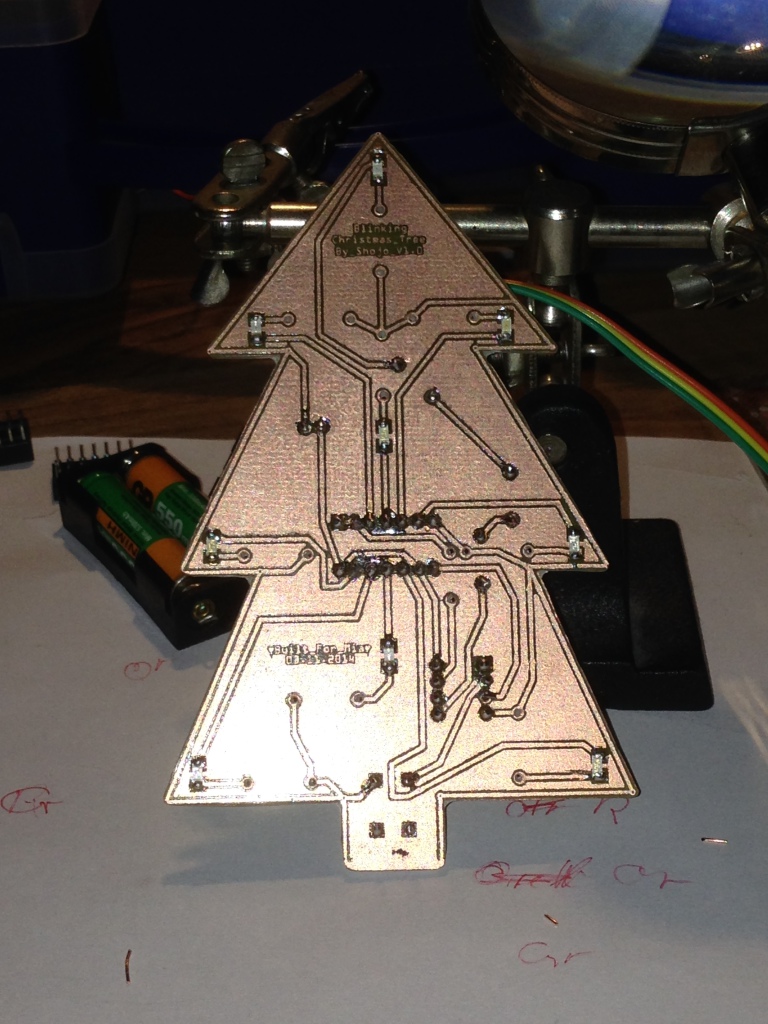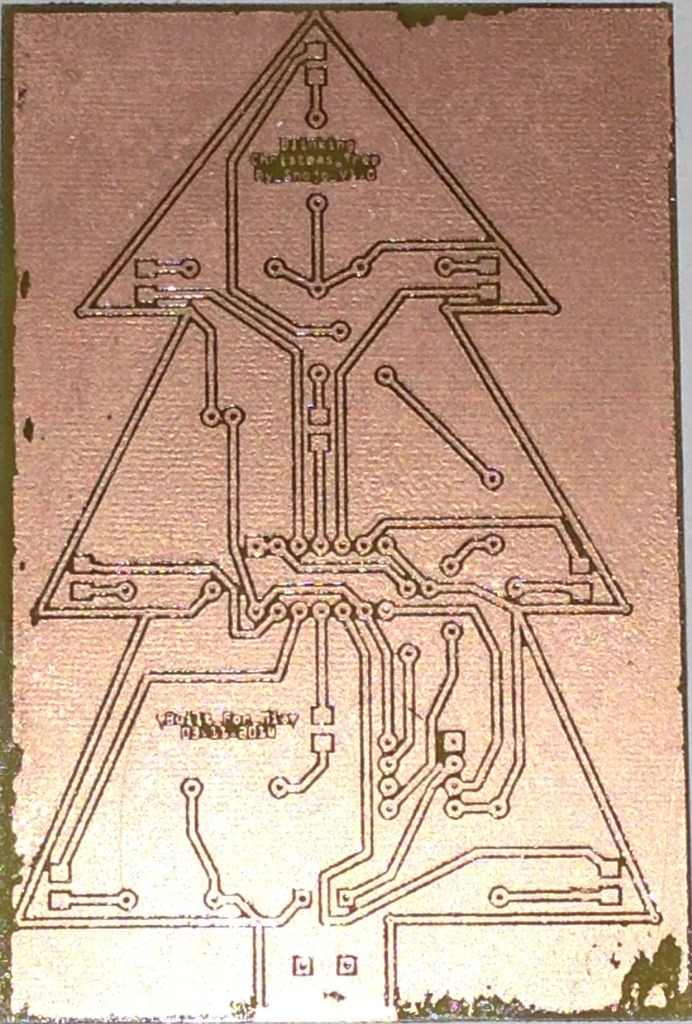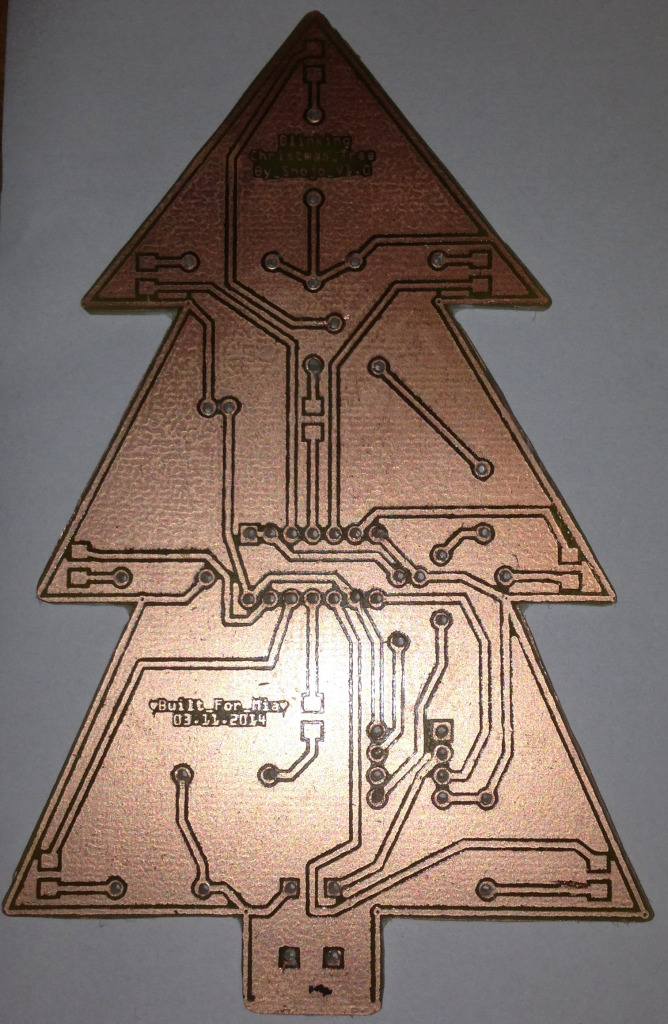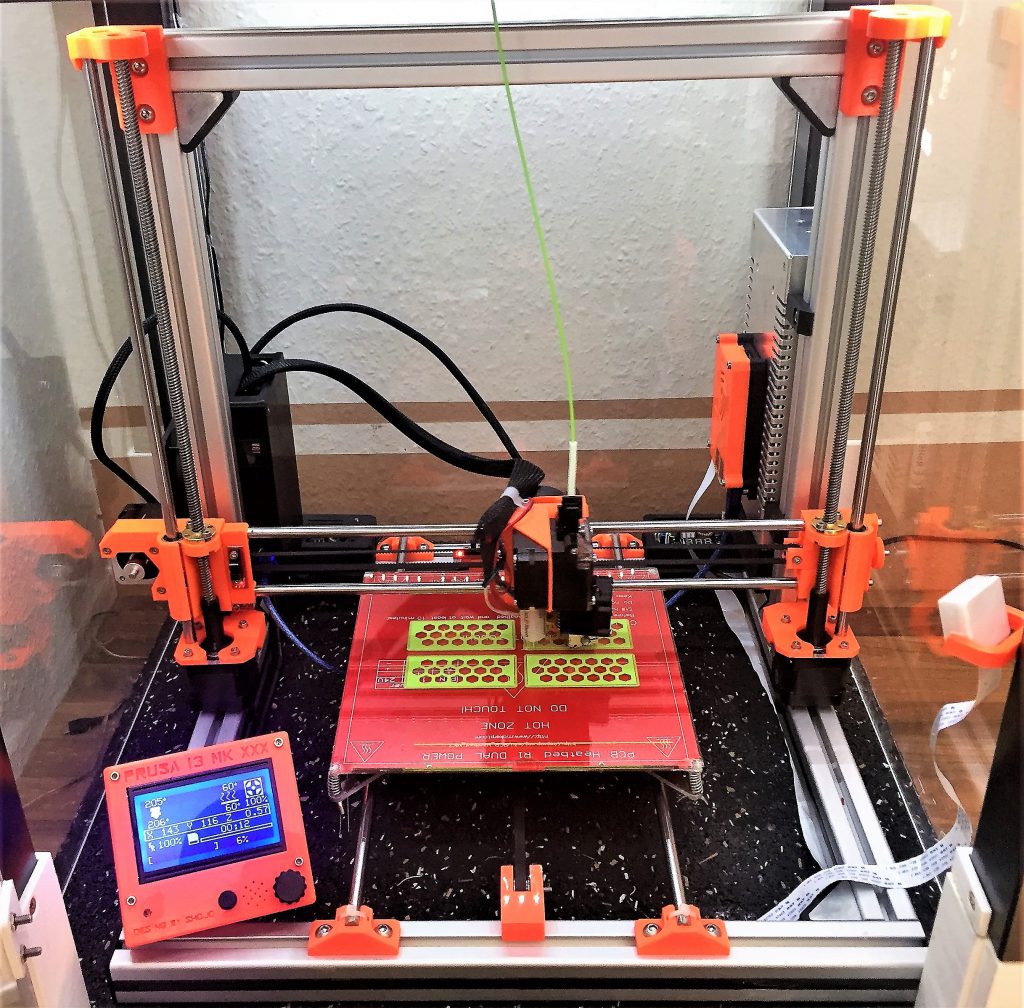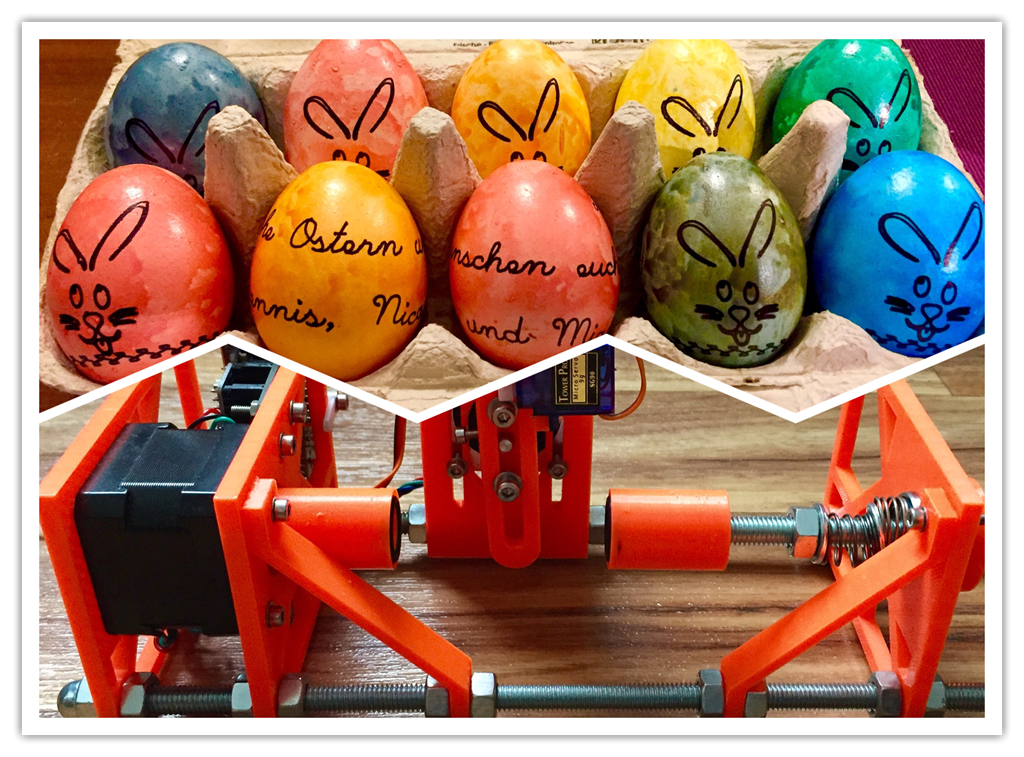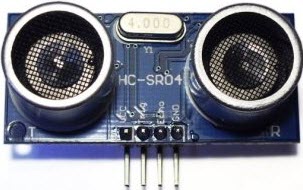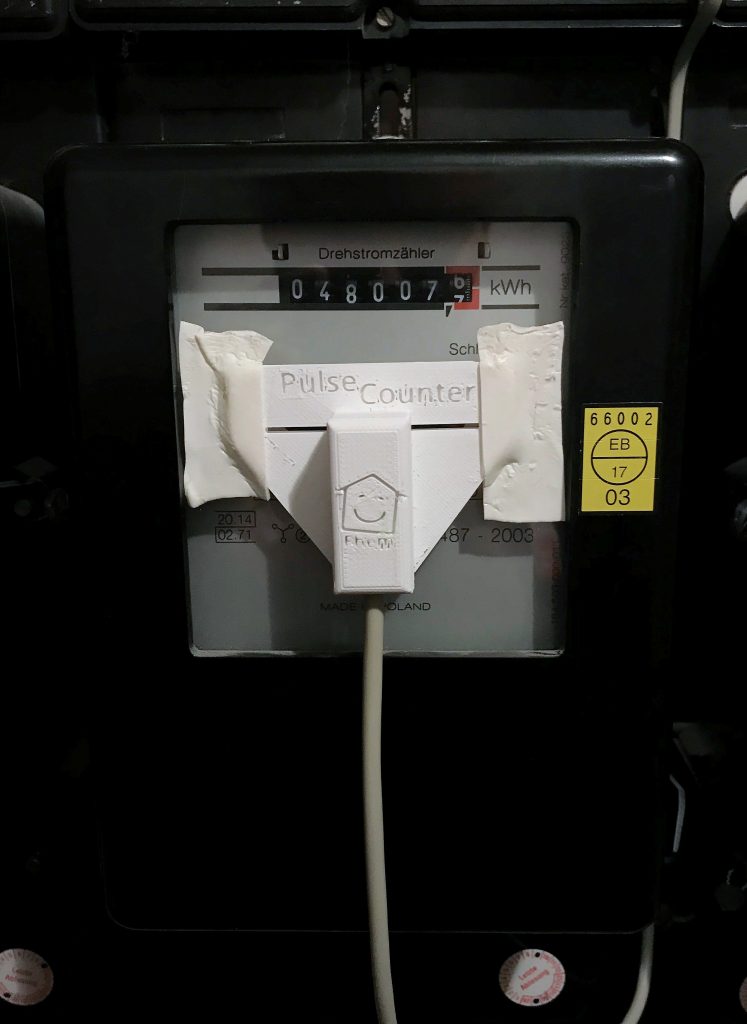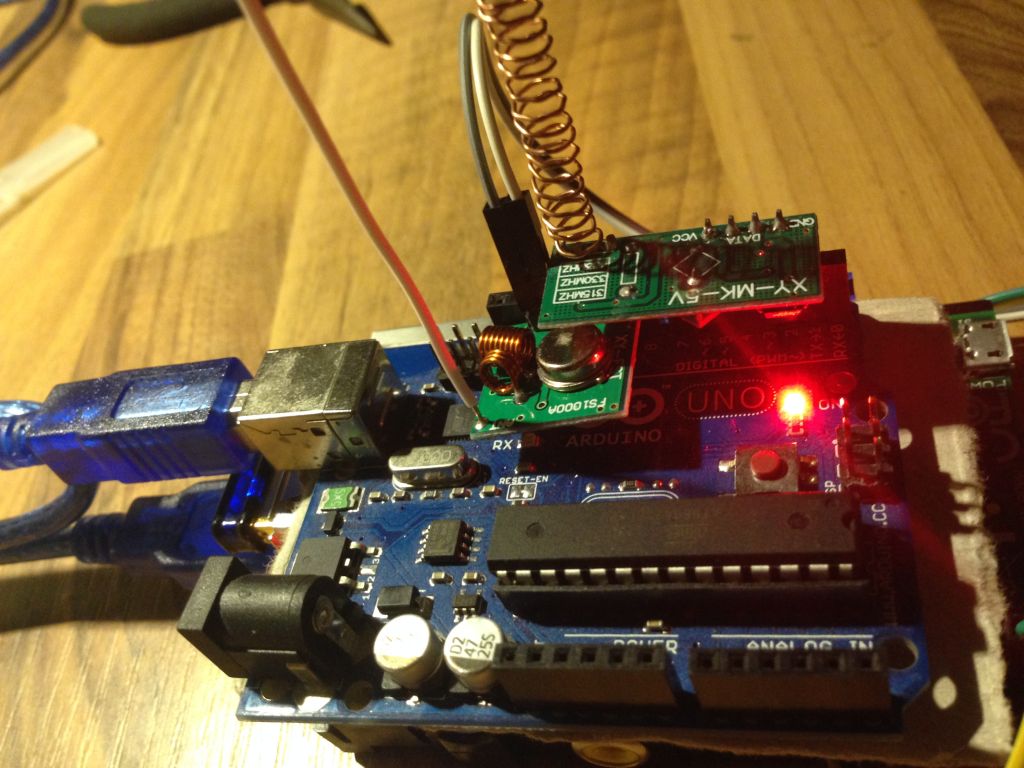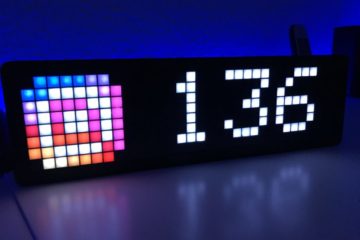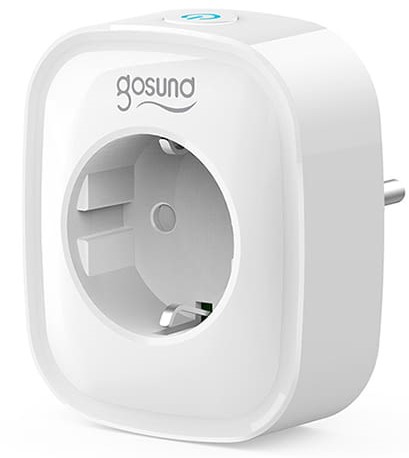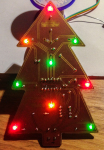
Es ist mal wieder soweit ich habe ein neues Projekt so gut wie fertiggestellt.
Da ich sowieso grade die Platinen Herstellung mit der Direkt-Toner-Methode ausprobieren wollte
habe ich für meine für meine Tochter eine kleine Spielerei gebaut.
Dabei kam dann diese Platine heraus … ein Tannenbaum der blinken kann.
Die ich dann noch mit einen Shift Register (74HC164N), einen ATtiny 85,
paar SMD(1206) LED´s und eine Taster bestückt habe.
Wenn der Baum eingeschaltet wird läuft er erstmal im Demo-Modus in dem er alle Blink Modis durchläuft,
wird der Taster gedrückt springt er aus dem Demo-Modus und man kann alle Modis einzelnd aufrufen.
Wird der Taster wieder 5 Sekunden gedrückt gehalten springt er wieder in dem Demo-Modus.
Hier noch paar Bilder dazu:
Hier einmal der Code:
#define ClockPin 4
#define DataPin 2
#define TrigerPin 3
#define StarPin 0
byte PushCount = 0;
byte HoldCount = 0;
long previousMillis = 0;
long StarMillis = 0;
long DemoMillis = 0;
long ButtonMillis = 0;
byte TempCount = 0;
long currentMillis = 0;
bool Reverse = false;
byte Fade = 10;
byte FadeSpeed = 5;
bool DemoMode = true;
bool ButtonPushed = false;
byte LED[30] =
{
//0 - 5
B00000000, B00001010, B00011011, B10111011, B11111011, B11111111,
//6 - 7
B11000011, B00111100,
//8 - 15
B10000000, B00100000, B01000000, B00000100, B00010000, B00001000, B00000010, B00000001,
//16 - 23
B10000000, B00100000, B01000000, B00000001, B00010000, B00000100, B00000010, B00001000,
//24 - 29
B10100000, B01000000, B00010001, B00000100, B00001010, B00000000
};
void setup()
{
pinMode(StarPin, OUTPUT);
pinMode(DataPin, OUTPUT);
pinMode(ClockPin, OUTPUT);
pinMode(TrigerPin, INPUT_PULLUP);
}
void loop()
{
currentMillis = millis();
// Püfen on der Button gedrückt wird
if (!digitalRead(TrigerPin) && (currentMillis - ButtonMillis) > 200)
{
ButtonMillis = currentMillis;
if (!ButtonPushed)
{
PushCount++;
DemoMode = false;
ButtonPushed = true;
HoldCount = 0;
}
// DemoMode wieder aktivieren
else if (HoldCount++ > 25)
{
DemoMode = true;
shiftOut(DataPin, ClockPin, MSBFIRST, LED[0]);
delay(200);
}
if (PushCount > 15)
PushCount = 0;
}
else if (digitalRead(TrigerPin))
ButtonPushed = false;
// Der Demo Modus Funktionswechsel alle 10 Sek. (wenn nichts gedrückt wurde)
if (DemoMode && (currentMillis - DemoMillis) > 10000)
{
DemoMillis = currentMillis;
PushCount++;
if (PushCount > 14)
PushCount = 0;
}
// Dauerhafter Fade für die Star-LED
FadeStar();
// Den Taster auf Eingabe auswerten
switch (PushCount)
{
case 0:
TwoDance();
break;
case 1:
DriftInAndOut();
break;
case 2:
RoundAndRound(false);
break;
case 3:
RoundAndRound(true);
break;
case 4:
RandomLight();
break;
case 5:
RandomShiftLight(false);
break;
case 6:
RandomShiftLight(true);
break;
case 7:
RandomDualShiftLight(false);
break;
case 8:
RandomDualShiftLight(true);
break;
case 9:
Jumping(false, false);
break;
case 10:
Jumping(false, true);
break;
case 11:
Jumping(true, false);
break;
case 12:
Jumping(true, true);
break;
case 13:
Rain(false);
break;
case 14:
Rain(true);
break;
default:
AllOn();
break;
}
}
void FadeStar()
{
if (currentMillis - StarMillis > 30)
{
StarMillis = currentMillis;
analogWrite(StarPin, Fade);
Fade = Fade + FadeSpeed;
if (Fade == 10 || Fade == 255)
{
FadeSpeed = -FadeSpeed;
}
}
}
void TwoDance()
{
if (currentMillis - previousMillis > 650)
{
previousMillis = currentMillis;
if (TempCount < 6 || TempCount > 7)
TempCount = 6;
shiftOut(DataPin, ClockPin, MSBFIRST, LED[TempCount]);
TempCount++;
}
}
void DriftInAndOut()
{
int Helper = TempCount;
if (currentMillis - previousMillis > 250)
{
previousMillis = currentMillis;
if (Reverse)
Helper = 5 - TempCount;
shiftOut(DataPin, ClockPin, LSBFIRST, LED[Helper]);
TempCount++;
if (TempCount > 5)
{
Reverse = !Reverse;
TempCount = 0;
}
}
}
void RoundAndRound(bool Inverse)
{
if (currentMillis - previousMillis > 180)
{
previousMillis = currentMillis;
if (TempCount > 15 || TempCount < 8)
TempCount = 8;
if (Inverse)
shiftOut(DataPin, ClockPin, MSBFIRST, LED[TempCount] ^ B11111111);
else
shiftOut(DataPin, ClockPin, MSBFIRST, LED[TempCount]);
TempCount++;
}
}
void RandomLight()
{
if (currentMillis - previousMillis > 180)
{
previousMillis = currentMillis;
shiftOut(DataPin, ClockPin, MSBFIRST, random(0, 255));
}
}
void RandomShiftLight(bool Inverse)
{
if (currentMillis - previousMillis > 160)
{
previousMillis = currentMillis;
if (Inverse)
shiftOut(DataPin, ClockPin, MSBFIRST, LED[15] << random(0, 8) ^ 255);
else
shiftOut(DataPin, ClockPin, MSBFIRST, LED[15] << random(0, 8));
}
}
void RandomDualShiftLight(bool Inverse)
{
if (currentMillis - previousMillis > 180)
{
previousMillis = currentMillis;
byte lights = (LED[15] << random(0, 4)) | (LED[8] >> random(0, 4));
if (Inverse)
shiftOut(DataPin, ClockPin, MSBFIRST, lights ^ 255);
else
shiftOut(DataPin, ClockPin, MSBFIRST, lights);
}
}
void Jumping(bool _Reverse, bool Inverse)
{
if (currentMillis - previousMillis > 180)
{
previousMillis = currentMillis;
if (_Reverse)
{
if (TempCount < 16 || TempCount > 23)
TempCount = 23;
}
else
{
if (TempCount < 16 || TempCount > 23)
TempCount = 16;
}
if (Inverse)
shiftOut(DataPin, ClockPin, LSBFIRST, LED[TempCount] ^ 255);
else
shiftOut(DataPin, ClockPin, LSBFIRST, LED[TempCount]);
if (_Reverse)
TempCount--;
else
TempCount++;
}
}
void Rain(bool Inverse)
{
if (currentMillis - previousMillis > 220)
{
previousMillis = currentMillis;
if (TempCount < 24 || TempCount > 29)
TempCount = 24;
if (Inverse)
shiftOut(DataPin, ClockPin, LSBFIRST, LED[TempCount] ^ 255);
else
shiftOut(DataPin, ClockPin, LSBFIRST, LED[TempCount]);
TempCount++;
}
}
void AllOn()
{
shiftOut(DataPin, ClockPin, MSBFIRST, LED[5]);
}Und noch ein Video:
